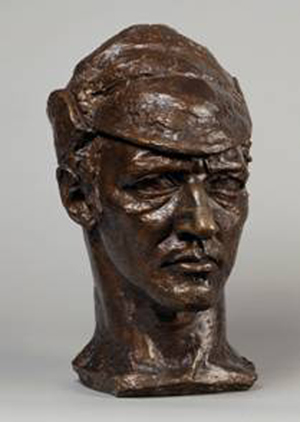
LONDON – The National Portrait Gallery, London, will unveil a display of portrait busts by Sir Jacob Epstein on March 30. All made during the period 1916-1951, 13 busts from the collection will be displayed in the round. The majority of the sculptures on display are executed in bronze and subjects depicted include actors, artists, authors, composers and politicians.
The sculptures will be complemented with photographs showing the studio space, the artist at work and the sculptures in progress. The photographs by Michael Peto and Ida Kar will provide unparalleled insight into Epstein’s artistic identity and practice.
Modeled in clay and cast in bronze or plaster, these busts were rooted in observation but were developed through expressive experimentation with form and texture to capture the presence of the sitter. “Jacob Epstein: Portrait Sculptor” will explore Epstein’s achievement and practice through his busts and will include some of the artist’s most celebrated portraits: Joseph Conrad, T.S. Eliot, Vaughan Williams and George Bernard Shaw. The Gallery’s recent acquisition of Epstein’s portrait of Jawaharlal Nehru will also form part of the display.
Of this portrait Epstein said: “At this time, soon after the assassination of Gandhi (in 1948), Nehru seemed burdened with the cares of office, and it was in this mood that I conceived this somber portrait.”
One of the 20th century’s leading sculptors, Jacob Epstein (1880-1959) was born in New York to Polish-Jewish parents and studied in Paris before moving to London in 1905. Epstein became a founding member of the London Group in 1913, and that same year had his first solo show at the Twenty-One Gallery, Adelphi, London. Epstein was knighted in 1954 and died in London on Aug. 19, 1959.
His works are held in major UK collections including: Tate Britain, Courtauld Institute of Art, Fitzwilliam Museum and National Museum of Wales. Major public sculptures include: Memorial to W.H. Hudson (Rima), 1925, Hyde Park, London; Night and Day, 1928-9, St. James’ Underground, London; Christ in Majesty, 1954-5, Llandaff Cathedral; and St. Michael and the Devil, 1956-8, Coventry Cathedral.
“Jacob Epstein was one of the 20th century’s greatest modernist sculptors and portraiture was central to his achievement. This display focuses on some of his finest portraits and illuminates the process behind their creation,” said Paul Moorhouse, 20th century curator, National Portrait Gallery, London.


